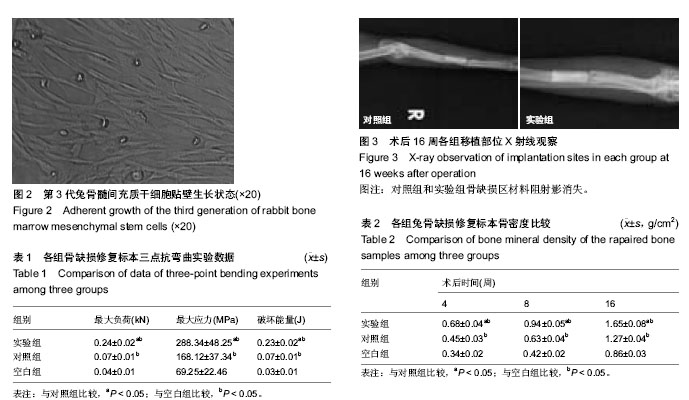| [1] Zhao L, Burguera EF, Xu HH, et al. Fatigue and human umbilical cord stem cell seeding characteristics of calcium phosphate-chitosan-biodegradable fiber scaffolds. Biomaterials. 2010;31(5):840-847.
[2] Zhao L, Weir MD, Xu HH. Human umbilical cord stem cell encapsulation in calcium phosphate scaffolds for bone engineering. Biomaterials. 2010;31(14):3848-3857.
[3] Fayaz HC, Giannoudis PV, Vrahas MS, et al. The role of stem cells in fracture healing and nonunion. Int Orthop. 2011; 35(11):1587-1597.
[4] Janicki P, Boeuf S, Steck E, et al. Prediction of in vivo bone forming potency of bone marrow-derived human mesenchymal stem cells. Eur Cell Mater. 2011;21: 488-507.
[5] Kagami H, Agata H, Tojo A. Bone marrow stromal cells (bone marrow-derived multipotent mesenchymal stromal cells) for bone tissue engineering: basic science to clinical translation. Int J Biochem Cell Biol. 2011;43(3):286-289.
[6] Sommeling CE, Heyneman A, Hoeksema H, et al. The use of platelet-rich plasma in plastic surgery: a systematic review. J Plast Reconstr Aesthet Surg. 2013;66(3):301-311.
[7] Namazi H. Enhancing bone healing during distraction osteogenesis with platelet-rich plasma: a novel molecular mechanism. Injury. 2012;43(7):1225-1226.
[8] Latalski M, Elbatrawy YA, Thabet AM, et al. Enhancing bone healing during distraction osteogenesis with platelet-rich plasma. Injury. 2011;42(8):821-824.
[9] Kanthan SR, Kavitha G, Addi S, et al. Platelet-rich plasma (PRP) enhances bone healing in non-united critical-sized defects: a preliminary study involving rabbit models. Injury. 2011;42(8):782-789.
[10] Gustavsson J, Ginebra MP, Engel E, et al. Ion reactivity of calcium-deficient hydroxyapatite in standard cell culture media. Acta Biomater. 2011;7(12):4242-4252.
[11] Weir MD, Xu HH. Culture human mesenchymal stem cells with calcium phosphate cement scaffolds for bone repair. J Biomed Mater Res B Appl Biomater. 2010;93(1):93-105.
[12] Yuan J, Zhang WJ, Liu G, et al. Repair of canine mandibular bone defects with bone marrow stromal cells and coral. Tissue Eng Part A. 2010;16(4):1385-1394.
[13] Zhou H, Weir MD, Xu HH. Effect of cell seeding density on proliferation and osteodifferentiation of umbilical cord stem cells on calcium phosphate cement-fiber scaffold. Tissue Eng Part A. 2011;17(21-22):2603-2613.
[14] Chen W, Zhou H, Weir MD, et al. Human embryonic stem cell-derived mesenchymal stem cell seeding on calcium phosphate cement-chitosan-RGD scaffold for bone repair. Tissue Eng Part A. 2013;19(7-8):915-927.
[15] Yasuda H, Yano K, Wakitani S, et al. Repair of critical long bone defects using frozen bone allografts coated with an rhBMP-2-retaining paste. J Orthop Sci. 2012;17(3):299-307.
[16] Ginebra MP, Espanol M, Montufar EB, et al. New processing approaches in calcium phosphate cements and their applications in regenerative medicine. Acta Biomater. 2010; 6(8):2863-2873.
[17] Xu HH, Zhao L, Weir MD. Stem cell-calcium phosphate constructs for bone engineering. J Dent Res. 2010; 89(12): 1482-1488.
[18] Zhao L, Weir MD, Xu HH. Human umbilical cord stem cell encapsulation in calcium phosphate scaffolds for bone engineering. Biomaterials. 2010;31(14):3848-3857.
[19] Zhao L, Weir MD, Xu HH. An injectable calcium phosphate- alginate hydrogel-umbilical cord mesenchymal stem cell paste for bone tissue engineering. Biomaterials. 2010; 31(25): 6502-6510.
[20] Habraken WJ, Liao HB, Zhang Z, et al. In vivo degradation of calcium phosphate cement incorporated into biodegradable microspheres. Acta Biomater. 2010;6(6):2200-2211.
[21] Zou D, Guo L, Lu J, et al. Engineering of bone using porous calcium phosphate cement and bone marrow stromal cells for maxillary sinus augmentation with simultaneous implant placement in goats. Tissue Eng Part A. 2012;18(13-14): 1464-1478.
[22] Bonewald LF. The amazing osteocyte. J Bone Miner Res. 2011;26(2):229-238.
[23] Sell SA, Wolfe PS, Ericksen JJ, et al. Incorporating platelet-rich plasma into electrospun scaffolds for tissue engineering applications. Tissue Eng Part A. 2011;17(21-22): 2723-2737.
[24] Riaz R, Ravindran C, Ramkumar, et al. Efficacy of platelet rich plasma in sinus lift augmentation. J Maxillofac Oral Surg. 2010; 9(3):225-230.
[25] Franco D, Franco T, Schettino AM, et al. Protocol for obtaining platelet-rich plasma (PRP), platelet-poor plasma (PPP), and thrombin for autologous use. Aesthetic Plast Surg. 2012;36(5): 1254-1259.
[26] Aberg J, Brisby H, Henriksson HB, et al. Premixed acidic calcium phosphate cement: characterization of strength and microstructure. J Biomed Mater Res B Appl Biomater. 2010; 93(2):436-441.
[27] Giocondi JL, El-Dasher BS, Nancollas GH, et al. Molecular mechanisms of crystallization impacting calcium phosphate cements. Philos Trans A Math Phys Eng Sci. 2010;368(1917): 1937-1961.
[28] Pina S, Vieira SI, Torres PM, et al. In vitro performance assessment of new brushite-forming Zn- and ZnSr-substituted beta-TCP bone cements. J Biomed Mater Res B Appl Biomater. 2010;94(2):414-420.
[29] Vazquez D, Takagi S, Frukhtbeyn S, et al. Effects of Addition of Mannitol Crystals on the Porosity and Dissolution Rates of a Calcium Phosphate Cement. J Res Natl Inst Stand Technol. 2010;115(4):225-232.
[30] Silva TS, Primo BT, Silva Júnior AN, et al. Use of calcium phosphate cement scaffolds for bone tissue engineering: in vitro study. Acta Cir Bras. 2011;26(1):7-11.
[31] van de Watering FC, van den Beucken JJ, Walboomers XF, et al. Calcium phosphate/poly(D,L-lactic-co-glycolic acid) composite bone substitute materials: evaluation of temporal degradation and bone ingrowth in a rat critical-sized cranial defect. Clin Oral Implants Res. 2012;23(2):151-159.
[32] Lee GS, Park JH, Won JE, et al. Alginate combined calcium phosphate cements: mechanical properties and in vitro rat bone marrow stromal cell responses. J Mater Sci Mater Med. 2011;22(5):1257-1268.
[33] Lee GS, Park JH, Shin US, et al. Direct deposited porous scaffolds of calcium phosphate cement with alginate for drug delivery and bone tissue engineering. Acta Biomater. 2011; 7(8):3178-3186.
[34] Zhao L, Tang M, Weir MD, et al. Osteogenic media and rhBMP-2-induced differentiation of umbilical cord mesenchymal stem cells encapsulated in alginate microbeads and integrated in an injectable calcium phosphate-chitosan fibrous scaffold.Tissue Eng Part A. 2011;17(7-8):969-979. |

.jpg)
.jpg)